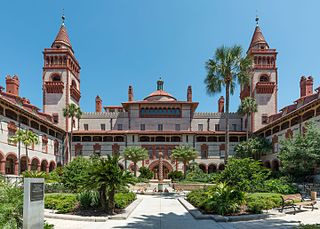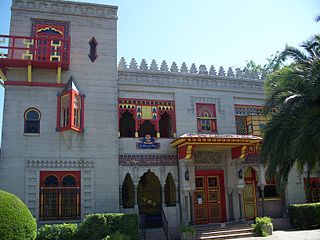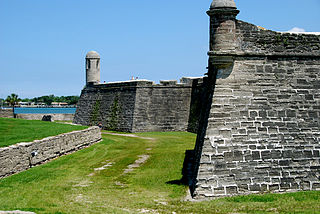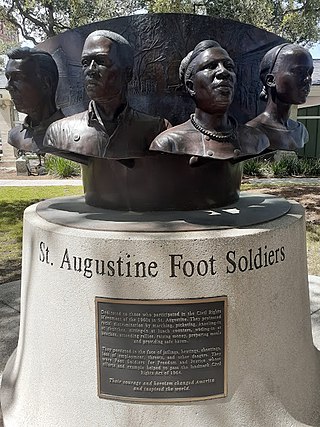David Nolan is an American author, civil rights activist, and historian. [1]
David Nolan is an American author, civil rights activist, and historian. [1]
Nolan was born in Cambridge, Massachusetts in 1946, the son of journalist Joseph T. Nolan and his artist wife Virginia.
He attended public schools in Bayside, New York and Waterbury, Connecticut, studied at the University of Virginia, and was active in the American Civil Rights Movement of the 1960s.
Since 1977 he has made his home in St. Augustine, Florida, known as the "nation's oldest city." From 1978-1980 he worked on the first official survey of old buildings in the Ancient City.
His first book, Fifty Feet in Paradise: The Booming of Florida, dealing with the booms and busts in the state's colorful real estate history, was published by Harcourt Brace Jovanovich in 1984, and he received the annual author's award from the Council for Florida Libraries.
He was a contributor to a literary tour guide of the state called The Book Lover's Guide to Florida that was published by Pineapple Press in 1992.
In 1995 he collaborated with artist Jean Ellen Fitzpatrick and photographer Ken Barrett to produce The Houses of St. Augustine, which has become the bestselling book about the Ancient City and its historic buildings.
He was a founder in 2002 of ACCORD (an acronym for "Anniversary to Commemorate the Civil Rights Demonstrations"), a group designed to honor the participants in the St. Augustine movement during the Civil Rights Movement. Demonstrations in St. Augustine in 1963 and 1964 led by Dr.Robert Hayling and Dr. Martin Luther King Jr. resulted in the passage of the landmark Civil Rights Act of 1964, one of the two great legislative accomplishments of the movement. ACCORD has launched a permanently marked Freedom Trail of historic sites of the civil rights movement that has gained international publicity. On July 2, 2014--the fiftieth anniversary of the signing of the Civil Rights Act of 1964--ACCORD opened the first civil rights museum in Florida, at 79 Bridge Street in St. Augustine, the former dental office of Dr. Robert Hayling. [2]
During Black History Month in 2009, Nolan received the Governor's Points of Light Award for outstanding community service. [3] [4]
On July 2, 2009, the 45th anniversary of the signing of the Civil Rights Act of 1964, he received the President's Volunteer Service Award from Barack Obama.
He has served as president of the Marjorie Kinnan Rawlings Society and trustee of the Fort Mose Historical Society.
He is a lecturer on historic, architectural, and literary subjects.
Title: David Nolan Papers Inclusive Dates: 1960-1987
Creator: Nolan, David, 1946- Call Number: Mss 773; PH 3905; PH 3906
Quantity: 2.4 c.f. (6 archives boxes) and 104 photographs
Repository: Wisconsin Historical Society, Library-Archives Division

St. Augustine is a city in and the county seat of St. Johns County located 40 miles south of downtown Jacksonville. The city is on the Atlantic coast of northeastern Florida. Founded in 1565 by Spanish explorers, it is the oldest continuously inhabited European-established settlement in what is now the contiguous United States.

The Casa Monica Hotel is a historic hotel located in St. Augustine, Florida, in the United States. It was originally named Casa Monica, then Cordova Hotel, then Alcazar Annex, and now has its original name again. The Casa Monica Hotel is one of the oldest hotels in the United States and is a member of the Historic Hotels of America in the National Trust for Historic Preservation.

The Ponce de Leon Hotel, also known as The Ponce, was an exclusive luxury hotel in St. Augustine, Florida, built by millionaire developer and Standard Oil co-founder Henry M. Flagler and completed in 1888. The hotel was designed in the Spanish Renaissance style as the first major project of the New York architecture firm Carrère & Hastings, which would go on to gain world renown.

Villa Zorayda is a house at 83 King Street in St. Augustine, Florida. Built in 1883 by the eccentric Boston millionaire Franklin W. Smith as his winter home, it was inspired by the 12th-century Moorish Alhambra Palace in Granada, Spain. Smith named it "Villa Zorayda", after one of the princesses in Washington Irving's Tales of the Alhambra. The building and part of Franklin Smith's art and antique collection were sold to Abraham Mussallem, a rug and antiquities merchant originally from Syria, in 1913. On September 23, 1993, it was added to the U.S. National Register of Historic Places. The Villa Zorayda Museum is still owned by the Mussallem family and contains the original art and antique collection assembled by Franklin Smith and Abraham Mussallem.

Saint Augustine's, Kilburn, is a Church of England church in the area of Kilburn, in North London, United Kingdom. Because of its large size and ornate architecture, it is sometimes affectionately referred to as "the Cathedral of North London", although the church is not a cathedral in any official sense.

The Clapp Octagon House is an historic octagonal house located at 62 Lighthouse Avenue in the historic Lighthouse Park neighborhood on the north end of Anastasia Island in St. Augustine, Florida. It was built in 1886 for Rollin N. Clapp of St. Louis, Missouri.

During most of the American Civil War the Florida city of St. Augustine was under Union control. Its Confederate history was exceedingly brief. One Union general and one Confederate general were natives of the Ancient City. Many officers on both sides had previous military experience in St. Augustine, particularly during the Second Seminole War. The city's historic Sea Wall was built in the 1830s, 1840s and 1850s by West Point engineers who went on to design military fortifications for both sides in the Civil War. Many black Union soldiers either came from St. Augustine, or settled there after the war, providing a leadership cadre for the community known as Lincolnville that was established in 1866. Many of the city's old cemeteries feature the distinctive marble tombstones marked "USCT" – United States Colored Troops.

The St. Augustine movement was a part of the wider Civil Rights Movement, taking place in St. Augustine, Florida from 1963 to 1964. It was a major event in the city's long history and had a role in the passage of the Civil Rights Act of 1964.

St. Augustine Foot Soldiers Monument is located near the corner of King St. and Charlotte St. in the Southeast corner of the Plaza de la Constitución, a historic public park in downtown St. Augustine, Florida. It is in remembrance of the people who engaged in various forms of peaceful protest in St. Augustine in the early 1960s to advance the cause of civil rights, contributing to the passage of the Civil Rights Act of 1964. The monument, commissioned by the St. Augustine Foot Soldiers Remembrance Project, Inc., was installed and unveiled in May, 2011.

Audrey Nell Edwards is an African-American civil rights activist, best known for her participation in the St. Augustine movement in 1963.
Robert Bagner Hayling was an American dentist and civil rights activist.
St. Augustine, Florida, the oldest continuously occupied settlement of European origin in the continental United States, was founded in 1565 by Spanish admiral Pedro Menéndez de Avilés. The Spanish Crown issued an asiento to Menéndez, signed by King Philip II on March 20, 1565, granting him various titles, including that of adelantado of Florida, and expansive privileges to exploit the lands in the vast territory of Spanish Florida, called La Florida by the Spaniards. This contract directed Menéndez to explore the region's Atlantic coast and report on its features, with the object of finding a suitable location to establish a permanent colony from which the Spanish treasure fleet could be defended and Spain's claimed territories in North America protected against incursions by other European powers.

The Monson Motor Lodge, at 32 Avenida Menendez, Saint Augustine, Florida, was in 1964 the site of a landmark protest event of the Civil Rights Movement. The site was before that occupied by the Monson House, a 19th-century boarding house.

University of Florida Historic St. Augustine, Inc. (UFHSA) is located at 48 King Street in St. Augustine, Florida. University of Florida encourages UFHSA to preserve and interpret state owned properties in St. Augustine that will in turn satisfy and support state needs of professionals in historic preservation, archaeology, cultural resources management, cultural tourism, history, and museum administration. UFHSA also seeks to meet the needs of locals in the state of Florida and in the city of St. Augustine, supporting educational internships and practicums.
Earle W. Newton, II (1917–2006) was a historian, preservationist, publisher, educator, and art benefactor.
The Order of La Florida is an award given by the City of St. Augustine, Florida to those who have rendered extraordinary services to the city.

The 1964 Monson Motor Lodge protest was part of a series of events during the civil rights movement in the United States which occurred on June 18, 1964, at the Monson Motor Lodge in St. Augustine, Florida. The campaign between June and July 1964 was led by Robert Hayling, Martin Luther King Jr., Ralph Abernathy, Andrew Young, Hosea Williams, C. T. Vivian and Fred Shuttlesworth, among others. St. Augustine was chosen to be the next battleground against racial segregation on account of it being both highly racist yet also relying heavily on the northern tourism dollar. Furthermore, the city was due to celebrate its 400th anniversary the following year, which would heighten the campaign's profile even more. Nightly marches to the slave market were organized, which were regularly attacked and saw the marchers beaten.
Mary Elizabeth Peabody was an American civil-rights and anti-war activist in the 1960's. She is best known for her participation in a sit-in protest in St. Augustine, Florida, which was orchestrated by prominent members of the Southern Christian Leadership Conference. As an elderly white woman, Peabody's role in the protest was to draw attention to the protest and the civil rights movement as a whole. Her white skin and elderly position enabled her to protest while remaining safe.
Esther Julia Burgess was a nonviolent campaigner in the Civil Rights movement. She was the wife of Reverend John Melville Burgess, the first Black bishop within the American Episcopal Church.